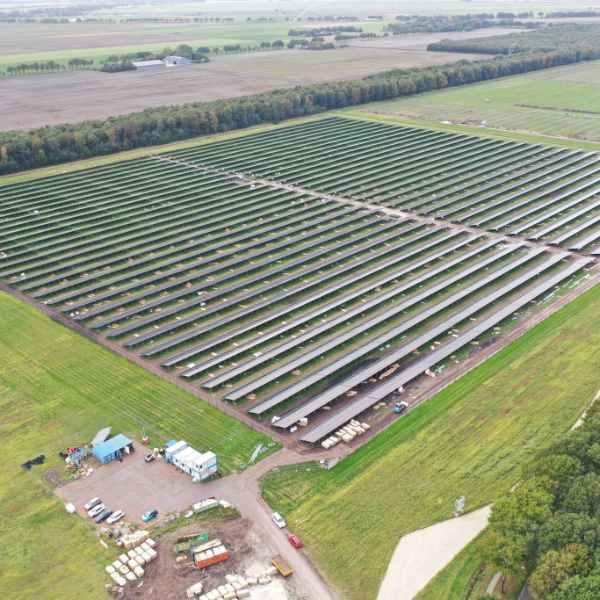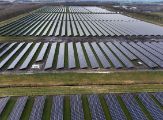Pekela Solar Park: local collaboration provides energy

Pekela Solar Park: local collaboration provides energy
One of the greenest solar parks in the Netherlands can be found in Pekela. In this project, energy generation from solar panels goes hand in hand with close attention to landscape integration, biodiversity, local ownership and local social benefits. As project manager, Witteveen+Bos has encouraged local involvement at all levels, using the Sustainable Design Principles (SDPs) as a guide.
In order to achieve the sustainable ambitions, the initial initiators, Schoorlemmer Landbouw and Windunie, were able to create the conditions for starting from a blank sheet of paper. This formed the starting point of a programme to construct a solar park that is groundbreaking in many respects. It is an example of a supported contribution towards the energy transition.
An essential component in this was the focus on the sustainable design principle of ‘participatory design’. This provided direction for creating the conditions for full stakeholder involvement in all phases of the project. Participatory design means not designing ‘for’ the local community but ‘with’ the local community. This increases support for the project, which in turn increases its implementation efficiency and ensures that the design will be more in line with the wishes of those living and working in the local community, ultimately increasing the benefits.
Participation of residents
Ensuring stakeholder participation has proven to be an important success factor in the realisation of Pekela Solar Park. Encouraged by Schoorlemmer Landbouw and Windunie, Witteveen+Bos made a conscious effort to persuade residents to participate in the project team, to join the project organisation, with the joining of Pekela Duurzaam and Bronnen van Ons as a result, and to form working groups to actively provide input on: a. landscape design and recreational co-utilisation, b. local benefits/financial participation and c. project communication.
As a result, the energy cooperative Pekela Duurzaam (Pekela Sustainable) became an integrated part of the project. Even before the permit request was submitted, the cooperative became a co-shareholder and joined the project meetings. This combination of forces has resulted in a widely supported design for the solar park, creating the conditions for landscape integration, boosting biodiversity, local ownership and local social benefits.
This generated a natural energy to make something truly amazing out of the project, with various sustainable design principles serving as tools. In the planning and design phase, the Participatory Design SDP helped pave the way for exploring opportunities and possibilities based on the Nature-based Design and the Multifunctional Design SDPs.
Ecosystem incentive
This resulted in design accents which made boosting biodiversity and the ecosystem part of the design. The solar panels have been positioned in such a way to provide ample light and space for growing strips of rich herbaceous grassland between the rows.
The soil itself will remain undisturbed for 25 years. No herbicides or fertilisers will be used, enabling nature to run its course while also contributing to reducing nitrogen emissions. It is a win-win situation. Sheep will be allowed to graze the site as part of an extensive mowing and management plan.
Biotope for birds
Part of the site has also been designed to attract field and meadow birds. Where possible, specific strips will also have water bodies with natural banks and planting, so that an interesting biotope is created for birds. It concerns a total area of 6.4 ha for field and meadow birds. This means that Pekela Solar Park also complies with provincial government policy of ensuring that roughly ten per cent is allocated to such birds.
The natural environment has been given even greater encouragement with the incorporation of native shrubs such as hawthorn, elder, hazel, creeping willow, Amelanchier and various other berry-producing species. These natural additions complement the already existing oak wood. The newly planted areas will contribute to the organic transition from the oak trees to the solar park.
19 hectares of additional recreation area
A popular foot and cycle path runs along and through the south-west side of the solar park towards Emergobos wood. This thoroughfare will form the main connecting axis with a new path through the solar park. In the east, this path connects to a gently meandering footpath. The result is a new path network from the village towards Emergobos wood. Creative input from residents has also resulted in setting up an ‘energy transition trail’, which starts from an information point near the village. Moreover, there are still opportunities for connecting to the existing (recreational) cycle path intersection.
A plan is also in place to build a 13-metre-high observation tower in the near future. Three potential locations have been identified in the design. A total of 19 ha of additional recreation area will be created around the solar park. In this way, Pekela Solar Park is contributing explicitly to greater recreational opportunities for residents, visitors and tourists.
Example with national allure
The realisation of Pekela Solar Park has proven to be an innovative and exemplary project for energy transition in the Netherlands in several ways. Remarkable results have been achieved in the field of stakeholder participation in planning and design as well as in the ownership structure. Nature development has been integrated as a specific goal, aimed at achieving a tangible increase in herbaceous grassland, native plants and trees and meadow birds. Realising and connecting foot and cycle paths and the planned observation tower have also contributed proactively to the quality of life of Pekela and the region. Moreover, residents are co-owners and will be able to decide for themselves in the coming years what to do with the returns and management of the solar park and the surrounding recreational amenities.
Pekela Solar Park in key figures
- Project area: 79 ha (net PV + landscape integration + field and meadow bird areas)
- 60 ha solar panels (net PV), total capacity of approximately 63 MW
- 125,000 solar panels
- 56,000,000 kWh of electricity, volume for approximately 16,000 households (3,500 kWh per year per household on average)
- 2,608,200 kg CO₂ savings per year
- Energy recoupment period Pekela Solar Park maximum 2 years
- Lifespan of solar panels + installation: > 25 years
- 19 ha landscape integration
- 19 ha herbaceous grass and plant species
- 42,000 shrubs planted
- New foot and cycle paths with connections to existing paths
More information?



